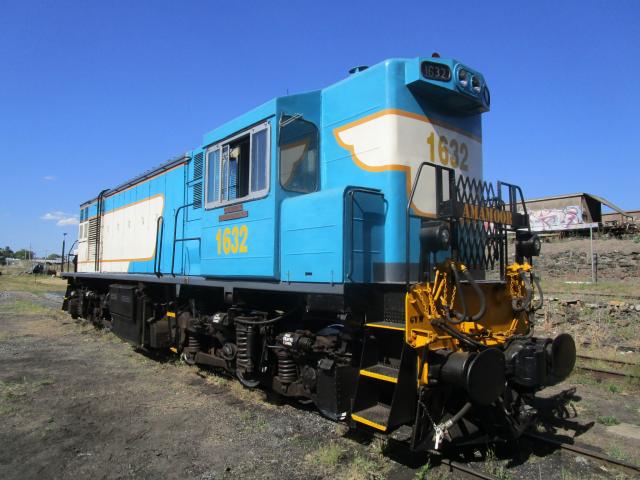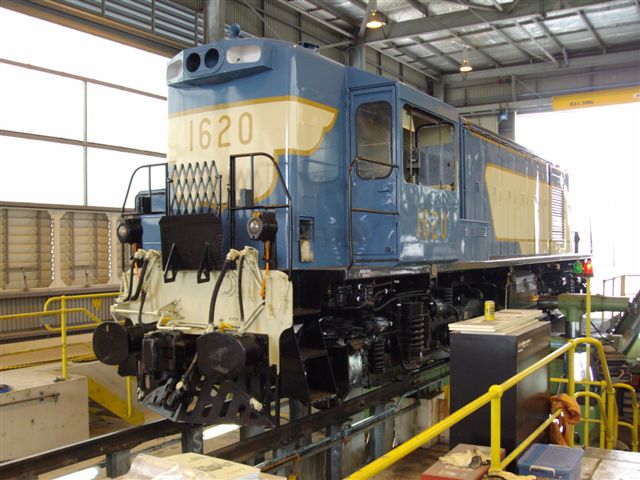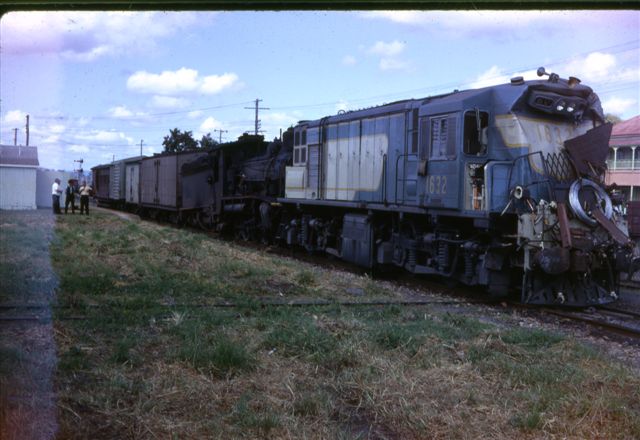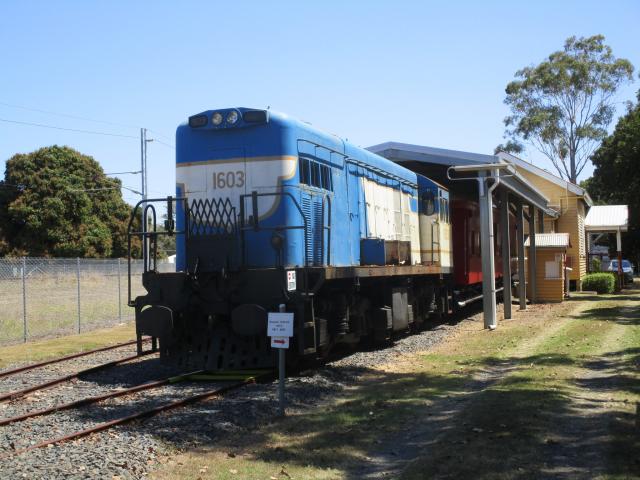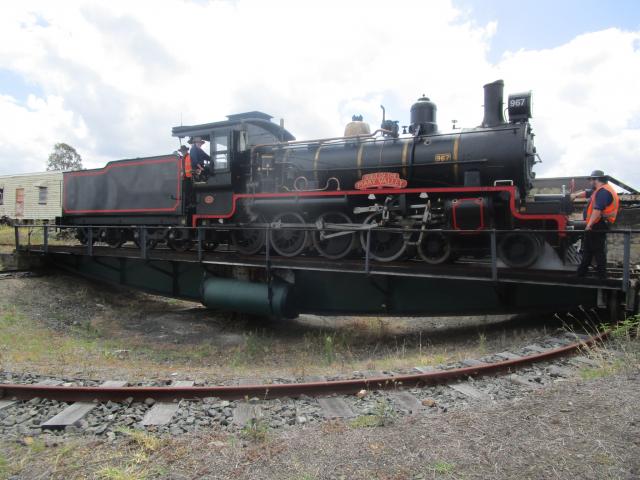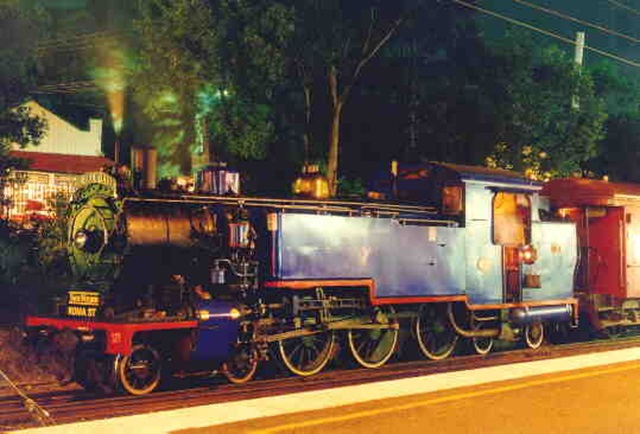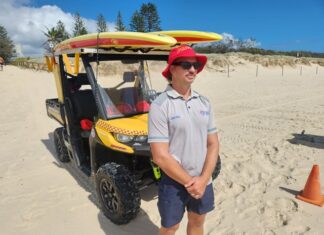Steam locomotives have advantages and disadvantages.
While they have many advantages, one disadvantage is the amount of power available for traction. The power produced from the boiler is transmitted to the driving wheels, which can be half or less of the actual wheels of the locomotive.
The C-17 967, of the Mary Valley Rattler, has eight driving wheels yet all in all it has 20 wheels, including pony and trailing truck and tender wheels.
Designs in history have tried to remedy this, with “tank” engines such as QGR’s DD17 class, or the Garratt type locomotive, of which QGR had the Beyer Garratt and the Australian Standard Garratt or the American Union Pacific 4000 locomotive, the Big Boy.
These steam locomotive designs attempted to get more power from as many driving wheels as possible and use the weight of the locomotive to increase power or tractive effort.
Alternatives to steam motive power on railways had been explored from the 1890s and by 1925 diesel-electric locomotives were being used in America, albeit as shunters or switchers.
After the conclusion of World War 2, the design, construction, and use of diesel locomotives on railways increased.
In Queensland the impact of World War 2 contributed to the rehabilitating and improving of Queensland railways.
The first orders for motive power by the Queensland Government Railways after World War 2, were for steam locomotives (the DD17, The BB18 1/4, the Beyer Garratt and the upgraded C-17).
However, in the early 1950s, the first orders for diesel-electric locomotives were placed with General Electric of the USA and English Electric of England. Competition between the American based Clyde/GM company and the English Electric company for diesel-electric locomotive contracts in Queensland was intense.
From this time on, diesel-electric locomotives started to replace steam locomotives, first on the Queensland Railway mainlines and then on the branch lines. Diesel-electric locomotives utilise a diesel engine to drive an electrical generator that produces electricity.
The electricity produced, powers electric traction motors, which drive the locomotive.
Essentially, this is a hybrid design.
The advantages of the DELs over steam locomotives were, that they were easier to operate and maintain, had a larger power to weight ratio, did not have the hammer blow of steam locomotives which damaged the track, and they could haul heavier loads.
As an example, a C-17 class steam locomotive could haul 265 tons between Monkland and Gympie.
A 1620 class locomotive could haul 550 tons over the same section.
In January 1962, a contract was made to English Electric for a 60-ton diesel-electric locomotive to be used on the Central West line based in Rockhampton.
These were the 1600 class and the first was delivered in December 1962.
These locomotives were the first entire class of DELs to have multiple unit control (meaning a one-crewed locomotive could be used to drive and control one or two uncrewed locomotives attached to the crewed locomotive), dual driving stations, a turbocharger aftercooler and delta cast steel bogies.
By the end of 1963, all were working in the Rockhampton and Alpha areas of Central Queensland.
It was 1965 when which Queensland Railways decided to eliminate all steam locomotives in eight to ten years.
This, however, was completed by 1969 and 70.
Also in 1965, a contract was awarded to the English Electric Co for the 1620 class locomotive and in 1967 the first was delivered.
This design, by English Electric, was in response to the Clyde/GM 1720 class 60-ton diesel-electric locomotive, which was ordered in 1965.
The 1620 class locomotive was a 60-ton locomotive and was a re-design and development of the 1600 class.
They were a short hood design that had all the electrical components in a cabinet within the driving cab.
This included the main on/off switch, main circuit breakers, and main contactors.
A new design of bogie called the delta bogie was fitted which improved the transfer of power for traction.
The 1620 class had a new arrangement for the radiators – instead of being horizontal they were placed vertically.
The air compressor, auxiliary generator, main generator, and load capacitor all were placed in the same compartment between the driving cab and the engine compartment.
The main air reservoir was changed from the horizontal position to the vertical position.
One design feature which was to create issues in the future, was that two banks of four batteries were moved from the access gangways to the engine compartment to recesses in the top of the fuel tank.
This caused battery acid to spill onto the floor of the recess and over time, caused leaks in the fuel tanks.
While some locomotive drivers preferred the 1600 class, because of their larger cabs, the 1620s were well-liked by the crews due to their having more power and a larger fuel capacity, which assisted in the longer distances of the central and northern areas of Queensland.
From 1967, the 1620 class began their working life in Brisbane and eventually, they were transferred north and worked in the Cairns, Townsville, Mackay, Rockhampton and central west areas.
The first nine 1620s were sent to Cairns and Townsville.
During the sugar season they were transferred to Mackay.
The next ten, which included 1632 and 1639, were sent to Rockhampton and Mackay.
Before 1969, DEL 1632 was involved in a collision with C-17 254 at Theebine, north of Gympie.
The remaining 1620 class locomotives remained in Brisbane for about a year, until they too were sent north.
This included DEL 1649.
In the far north, the 1620s worked on the Tableland services and the Kuranda tourist trains.
It has been quoted that the areas around Townsville, Mackay, Rockhampton and west from these major centres became an English Electric stronghold, where both the company’s 90 and 60 tonners were commonplace.
As a historical note, with the 1620 class locomotives sent to the Rockhampton areas to replace the steam locomotives, DEL 1632 may have replaced and supplanted steam locomotive C 17 967.
Both locomotives are operated by the Mary Valley Rattler.
By the 1980s, due to operational changes in Central Queensland, 1620 class locomotives were re-allocated to Brisbane and Southeast Queensland. Due to their lower power, they were not preferred for suburban passenger work and were used on local freight trains.
An example is shown in the YouTube documentary, Mary Valley pineapple train.
By the late 1980’s and early 1990’s, due to the upgrading of rail lines in central and north Queensland, the closing of branch lines and the utilisation of more powerful locomotives, the 1620 class had started to be withdrawn and stored.
Eventually, by 1996, all had been withdrawn and either sold to the Philippines, scrapped, or were sold to tourist and heritage railways.
In 2023, there are six 1620 class locomotives within Queensland.
The 1620, 1650 and 1651 are stored at the Ipswich Railway workshops and are part of the Queensland Rail heritage fleet and assets.
The 1632, 1649 and 1639 are based at Gympie.
DEL 1632 is utilised by the Mary Valley Rattler for shunting, maintenance, recovery, and excursion operations.
DEL 1649 is being assessed for static preservation with DEL 1639 being used for parts for DEL 1632 and DEL 1649.
Since its commissioning on 20 July 1967, DEL 1632 has been in continuous use.
The specific history of DEL 1632 will be the focus of a future article.

